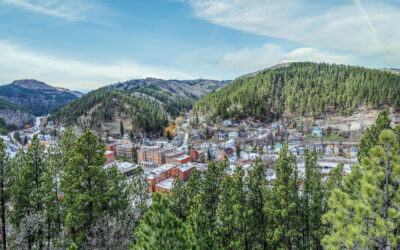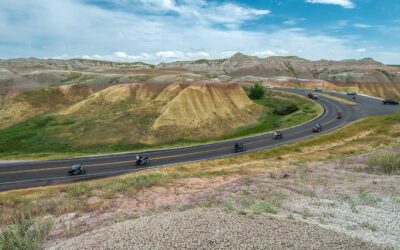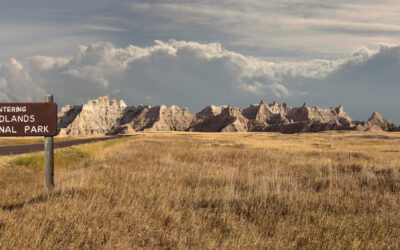Mount Rushmore, a symbol of American history and democracy, stands as a monumental tribute to four of the nation’s most revered presidents. Carved into the granite face of South Dakota’s Black Hills, this colossal sculpture is more than just a marvel of engineering; it’s a gateway to the rich tapestry of stories, cultures, and landscapes that define the region. For history buffs and travelers alike, comprehensive tours of Mount Rushmore offer an immersive journey through time, artistry, and nature. In this article, we’ll explore the multifaceted experiences that await at this iconic American landmark.
Key Takeaways
- Mount Rushmore is not only an engineering feat but also a portal to America’s past, encompassing the legacies of four great presidents.
- The monument’s creation is a story of vision and determination, with intricate symbolism woven into its design.
- Surrounding Mount Rushmore, the Black Hills and South Dakota’s landscapes offer a deeper connection with Native American history and natural beauty.
- The national memorial is a hub for cultural activities, including artistic showcases, annual events, and regional cuisine that celebrate its significance.
- Visitors planning a trip should consider the best times to visit, accommodation options, and park accessibility to optimize their Mount Rushmore experience.
Unveiling the Faces of History: A Guide to Mount Rushmore’s Past
The Presidential Legacy Carved in Stone
Mount Rushmore National Memorial stands as a testament to the monumental achievements and enduring legacies of four U.S. presidents: George Washington, Thomas Jefferson, Theodore Roosevelt, and Abraham Lincoln. Each face, towering 60 feet high, was chosen to represent key moments in American history and the nation’s growth.
The selection of these presidents was no coincidence. Washington signifies the birth of the United States, Jefferson the expansion, Roosevelt the development, and Lincoln the preservation. This symbolism is etched not only in stone but in the fabric of American culture.
While the grandeur of Mount Rushmore is widely recognized, few are aware of the intricate process behind its creation. Sculptor Gutzon Borglum led the project, which took 14 years (1927-1941) and the dedication of over 400 workers to complete. Despite the challenges, no lives were lost during construction, a remarkable feat considering the scale and risk involved.
Adjacent to Mount Rushmore, the Crazy Horse Memorial is another colossal endeavor, dedicated to the Native American leader Crazy Horse. Unlike the federally funded Rushmore, Crazy Horse is financed by visitors and donations, and when finished, it will stand as the world’s largest mountain carving.
The Visionaries Behind the Monument
Mount Rushmore stands as a testament to the ingenuity and determination of those who envisioned and sculpted it. The monument’s creation was spearheaded by Doane Robinson, known as the ‘Father of Mount Rushmore,’ whose idea it was to promote tourism in South Dakota by carving the likenesses of famous figures into the Black Hills region. Robinson’s vision was brought to life by sculptor Gutzon Borglum, who, along with his son Lincoln Borglum, transformed the granite face of Mount Rushmore into the iconic landmark we know today.
The project was an immense undertaking, involving hundreds of workers and the innovative use of dynamite for precision carving. It was not without its challenges, including funding issues and the harsh South Dakota weather. Yet, the dedication of the team prevailed, resulting in a masterpiece of American art and engineering.
South Dakota offers a variety of attractions, including museums, parks, and regions. Explore the state’s rich history and heritage through its diverse museums. For those looking to delve deeper into the stories of the visionaries behind Mount Rushmore, a visit to the nearby museums and visitor centers can provide a wealth of information and context to the monument’s grandeur.
Decoding the Symbolism of Mount Rushmore
Mount Rushmore National Memorial is not just a marvel of human craftsmanship but also a canvas of profound symbolism. Each of the four presidents carved into the granite face of the Black Hills represents a unique aspect of the American experience. George Washington stands as the birth of the nation, reflecting the struggle for independence and the establishment of a republic. Thomas Jefferson symbolizes the growth of the United States, notably through the Louisiana Purchase and his advocacy for democracy.
Theodore Roosevelt, with his rugged visage, embodies the development of the country, highlighting the industrial revolution and the nation’s emergence as a global power. Lastly, Abraham Lincoln represents the preservation of the Union, his leadership during the Civil War, and the principles of freedom and equality. Together, these colossal figures not only depict the physical likenesses of the leaders but also encapsulate the enduring values and challenges of their respective eras.
The monument’s location also holds significant meaning. The Black Hills are sacred to the Lakota Sioux, and the choice to carve the faces of American presidents into this landscape is a subject of ongoing debate and reflection about cultural representation and historical narrative. As visitors gaze upon the grandeur of the monument, they are invited to ponder the complex tapestry of history that Mount Rushmore represents.
Beyond the Granite: Exploring the Surrounding Wonders
The Hidden Trails of the Black Hills
The Black Hills of South Dakota, known for their lush forests and granite peaks, offer a treasure trove of hiking trails for those looking to explore beyond the iconic faces of Mount Rushmore. Discover a different side of South Dakota’s natural wonders as you traverse paths that wind through the heart of this ancient mountain range.
The trails range from easy strolls to challenging hikes, each promising its own unique experience. Here’s a quick guide to some of the most popular trails:
- Sylvan Lake Shore Trail: An easy, 1-mile loop around the serene Sylvan Lake, perfect for families.
- Harney Peak Trail: A moderate to strenuous 7-mile round trip that leads to the highest point in South Dakota.
- Sunday Gulch Trail: A 4-mile loop with a bit more rugged terrain, offering a mix of forest and boulder fields.
While the trails offer a peaceful escape, they also serve as a reminder of the region’s rich history, including the significance of the Black Hills to the Native American tribes who consider it sacred land. As you hike, take a moment to appreciate the diverse regions and unique experiences that South Dakota has to offer.
Native American History in the Shadow of the Mountain
Mount Rushmore, known for its colossal presidential faces, stands as a symbol of American history. However, the land it occupies holds a deeper narrative, one that predates the monument by centuries. The Black Hills, or "Paha Sapa" to the Lakota people, are considered sacred and are central to their creation stories. The significance of this area to Native American culture cannot be overstated.
The history of Native Americans in the region is rich and complex, involving numerous tribes and a tapestry of traditions. To truly appreciate the monument’s context, one must delve into the stories of the original inhabitants. The Lakota, Dakota, and Nakota (Sioux) tribes, along with the Cheyenne, Arapaho, and others, have all left their mark on these lands. Efforts like the Shakopee Mdewakanton Sioux Community’s campaign to change perspectives on Native Americans in Minnesota schools highlight the ongoing journey towards recognition and respect for these cultures.
- Lakota, Dakota, Nakota (Sioux)
- Cheyenne
- Arapaho
Understanding the past is crucial for visitors who wish to grasp the full meaning of Mount Rushmore. It’s not just about the faces carved in stone; it’s about acknowledging the rich tapestry of history that envelops the area. By exploring the narratives of the Native American tribes, one gains a more complete picture of South Dakota’s attractions and the true legacy of the Black Hills.
The Wildlife of South Dakota’s Pristine Landscapes
South Dakota’s natural beauty extends far beyond the monumental faces of Mount Rushmore. The state’s diverse ecosystems are a haven for wildlife enthusiasts and photographers alike. From the roaming bison to the elusive mountain lion, the region’s fauna reflects the richness of the Great Plains and the ruggedness of the Badlands.
The Black Hills, a small, isolated mountain range, provides a unique habitat for a variety of species. Here, visitors might spot mule deer, pronghorns, and even bighorn sheep grazing amidst the ponderosa pines. Birdwatchers can delight in the sight of golden eagles, peregrine falcons, and the occasional bald eagle soaring overhead.
For those interested in the broader ecological tapestry, South Dakota offers a variety of attractions including hiking trails, state parks, and nature preserves like Adams Homestead and Bear Butte State Park. These protected areas not only offer a glimpse into the wildlife but also serve as critical conservation sites ensuring the survival of species and the balance of ecosystems.
To help you plan your wildlife viewing adventure, consider the following points:
- Research the best times of day for wildlife activity, typically dawn and dusk.
- Stay informed about the specific habitats and behaviors of the animals you wish to observe.
- Respect the wildlife by maintaining a safe distance and not disrupting their natural behaviors.
- Take advantage of guided tours for expert insights and potential access to less-traveled areas.
The Cultural Tapestry of Mount Rushmore
Artistic Expressions: From Sculpture to Souvenirs
Mount Rushmore National Memorial is not only a testament to monumental sculpture but also a hub for various forms of artistic expressions. Visitors can explore a range of souvenirs that capture the essence of this iconic landmark. From intricate replicas of the monument to locally crafted items, the souvenir shops offer a piece of history for everyone to take home.
The artistry of Mount Rushmore extends beyond the granite faces. Local artisans draw inspiration from the monument, creating unique pieces that reflect the cultural and historical significance of the site. These items range from traditional Native American crafts to modern interpretations of the presidents’ likenesses in various mediums.
For those interested in the artistic process, several workshops and demonstrations are available, showcasing the skills and techniques used to create these memorable keepsakes. Here’s a quick look at some of the artistic offerings:
- Handcrafted pottery and flameware
- Black and white prints encapsulating the presidents against serene clouds
- Custom jewelry with motifs of the monument
- Traditional Native American beadwork and textiles
Each item tells a story, connecting visitors to the rich tapestry of Mount Rushmore’s legacy.
The Annual Events That Celebrate Mount Rushmore
Mount Rushmore serves as a backdrop for a variety of annual events that celebrate American history, culture, and community. From patriotic commemorations to cultural festivals, these gatherings bring together locals and visitors alike, offering a unique way to experience the monument beyond its stoic granite facade.
One of the most iconic events is the Mount Rushmore Independence Day Celebration. This event includes a spectacular fireworks display, which was resumed in 2020 after a decade-long hiatus due to wildfire concerns. The celebration is a testament to the national pride and historical significance that the monument embodies.
Other notable events include the Native American Day Celebration, which honors the rich heritage of the indigenous tribes of the region. The event features traditional music, dance, and storytelling, providing a profound contrast and complement to the presidential narratives carved into the mountain.
Here’s a quick glance at some of the key events:
- Mount Rushmore Independence Day Celebration
- Native American Day Celebration
- Black Hills Powwow
- Sturgis Motorcycle Rally (nearby event)
Each event offers a distinct perspective on the monument and its place in American culture, making a visit to Mount Rushmore a multi-dimensional experience.
Local Flavors: Sampling South Dakota’s Culinary Delights
South Dakota’s culinary scene is as rich and diverse as its landscapes. From the traditional Native American dishes to the hearty Midwestern cuisine, there’s a flavor for every palate. Local eateries pride themselves on using fresh, locally-sourced ingredients to create mouthwatering dishes that reflect the state’s agricultural heritage.
When it comes to must-try foods, chislic, a type of cubed meat skewer, tops the list. This South Dakota specialty is often made with wild game or beef and can be found at many local pubs and restaurants. For those with a sweet tooth, the state’s homemade pies, featuring seasonal fruits like chokecherries and wild plums, are an absolute delight.
Here’s a quick guide to some of the iconic South Dakota dishes and where to find them:
- Chislic – Any local pub or grill
- Bison Burgers – Custer State Park resorts
- Kuchen – German bakeries throughout the state
- Indian Tacos – Powwows and Native American gatherings
While exploring South Dakota’s cultural and historical sites, such as Good Earth State Park and the Minuteman Missile Site, make sure to indulge in the local cuisine to fully experience the state’s rich heritage.
Photography and Videography at the National Memorial
Capturing the Majesty: Tips for Photographers
Mount Rushmore offers a unique challenge and opportunity for photographers. The interplay of light and shadow across the presidential faces can create stunning images, but it requires some planning. The golden hours of sunrise and sunset provide the most dramatic lighting and are highly recommended for the best shots. Here are a few tips to help you capture the majesty of Mount Rushmore:
- Understand the light: The orientation of the monument means that lighting conditions change throughout the day. Early morning light casts a warm glow, while late afternoon can bring out the textures of the granite.
- Use the right gear: A tripod can help stabilize your shot, especially in low light conditions. Consider a polarizing filter to reduce glare and enhance the blue of the sky.
- Experiment with angles: Don’t just stick to the viewing platform; explore the area to find unique perspectives. The Presidential Trail offers several vantage points.
Remember to respect the natural environment and other visitors while you set up for your perfect shot. And always check the latest park regulations regarding photography equipment and drone usage to ensure you’re in compliance.
The Best Spots for That Perfect Shot
Mount Rushmore National Memorial offers photographers a plethora of vantage points to capture the grandeur of the presidential faces. The Avenue of Flags provides a symmetrical frame leading up to the mountain, ideal for a sense of scale and depth. For those seeking a close-up, the Grandview Terrace offers an elevated position directly in front of the monument.
Another not-to-be-missed spot is the Sculptor’s Studio, where visitors can get a unique perspective of the monument with interpretive insights. Nature enthusiasts may prefer the less crowded trails, such as the Presidential Trail, which affords intimate views and the chance to photograph local flora and fauna against the backdrop of the monument.
When planning your photography excursion, consider the time of day for the best natural lighting. Early morning and late afternoon provide soft, golden hues that can dramatically enhance your images. Here’s a quick guide to help you time your visit:
- Early Morning: Capture the warm sunrise light.
- Midday: Take advantage of the high sun for clear, bright photos.
- Golden Hour: Enjoy the rich, warm tones before sunset.
- Twilight: Experiment with the changing light as day turns to night.
Remember, while Mount Rushmore is a photographer’s dream, it’s also a place of historical significance. Respect the site and fellow visitors as you seek out your perfect shot.
Drone Regulations and Ethics in National Parks
When it comes to capturing the grandeur of Mount Rushmore from the skies, drone enthusiasts must adhere to strict regulations and ethical guidelines. Drones are prohibited in all national parks, including Mount Rushmore, under the Code of Federal Regulations (36 CFR 1.5). This rule is in place to protect wildlife, ensure visitor safety, and preserve the tranquility of these natural sanctuaries.
If you’re planning to use a drone for photography or videography near national parks, it’s crucial to respect the boundaries and consider the privacy of others. Here are some key points to remember:
- Always check local laws and regulations before flying a drone.
- Avoid flying over private property without permission.
- Be mindful of wildlife and avoid disturbing animals with your drone.
- Never interfere with emergency response operations such as firefighting.
Violating these regulations can result in hefty fines and even confiscation of your drone. For those looking to capture aerial footage legally, consider hiring a professional service with the necessary permits, or look for alternative locations where drone use is permitted.
Planning Your Pilgrimage to Mount Rushmore
Choosing the Best Time to Visit
Timing your visit to Mount Rushmore can greatly enhance your experience. Weather conditions play a crucial role in determining the best time to visit. The summer months, from late May to early September, offer warm temperatures and clear skies, ideal for viewing the monument and exploring the surrounding Black Hills. However, this is also the peak tourist season, so expect larger crowds and higher accommodation rates.
For those looking to avoid the hustle and bustle, the shoulder seasons of spring and fall provide a quieter experience with the added beauty of seasonal foliage. Winter visits can be magical with the snow-covered landscape, but be prepared for cold temperatures and limited access to some park facilities.
Here’s a quick reference for the best times to visit:
- Late May to Early September: Warm weather, clear skies, peak tourist season.
- Spring and Fall: Fewer crowds, moderate temperatures, beautiful foliage.
- Winter: Snowy scenery, cold temperatures, some facility closures.
Accommodations and Amenities Nearby
When planning your visit to Mount Rushmore, finding the right place to stay is crucial for a comfortable and memorable experience. Keystone, located just a stone’s throw from the monument, offers a variety of accommodations to suit every preference and budget. From the rustic charm of lodges nestled in the Black Hills to modern hotels with all the amenities, you’ll find the perfect spot to unwind after a day of exploration.
For those seeking a touch of luxury, the EO Bungalows and K Bar S Lodge are highly rated options that blend comfort with the natural beauty of the Black Hills. If you’re traveling with family or prefer a more budget-friendly choice, the Comfort Inn & Suites offers proximity to both Custer State Park and Mount Rushmore. Here’s a quick list of some top-rated accommodations:
- EO Bungalows, Black Hills – 9.3 Wonderful
- K Bar S Lodge, Ascend Hotel Collection – 8.9 Excellent
- Comfort Inn & Suites Near Custer State Park and Mt Rushmore
Beyond your night’s stay, the area is replete with amenities to enhance your visit. From local eateries serving South Dakota’s culinary delights to shops where you can pick up unique souvenirs, Keystone caters to all your needs. Remember to book your accommodations well in advance, especially during peak tourist seasons, to secure your ideal lodging.
Navigating the Park: Accessibility and Tour Options
Mount Rushmore National Memorial offers a seamless experience for visitors of all abilities, ensuring that the grandeur of this historic site is accessible to everyone. The park provides a variety of tour options to cater to different interests and needs, from self-guided walks to ranger-led programs.
For those who prefer to explore at their own pace, the Presidential Trail offers an up-close view of the monument. It’s a 0.6-mile loop with multiple viewing areas, including the Grand View Terrace and the Sculptor’s Studio. For accessibility information and services, the visitor center is your go-to resource, offering braille brochures, assisted listening devices, and more.
Group tours and educational programs are available for those looking for a more structured visit. These tours often delve deeper into the history and significance of the monument and can be booked in advance through the park’s website. The website page features attractions, places to stay, parks, regions, and activities in South Dakota, including museums, outdoor attractions, lodging, and various categories for visitors to explore.
Here’s a quick reference for tour options and accessibility services:
- Self-guided Presidential Trail
- Ranger-led programs and talks
- Educational group tours
- Visitor center resources (braille brochures, listening devices)
- Service animal accommodations
Remember to check the official Mount Rushmore website for the latest information on tour schedules and accessibility services before planning your visit.






